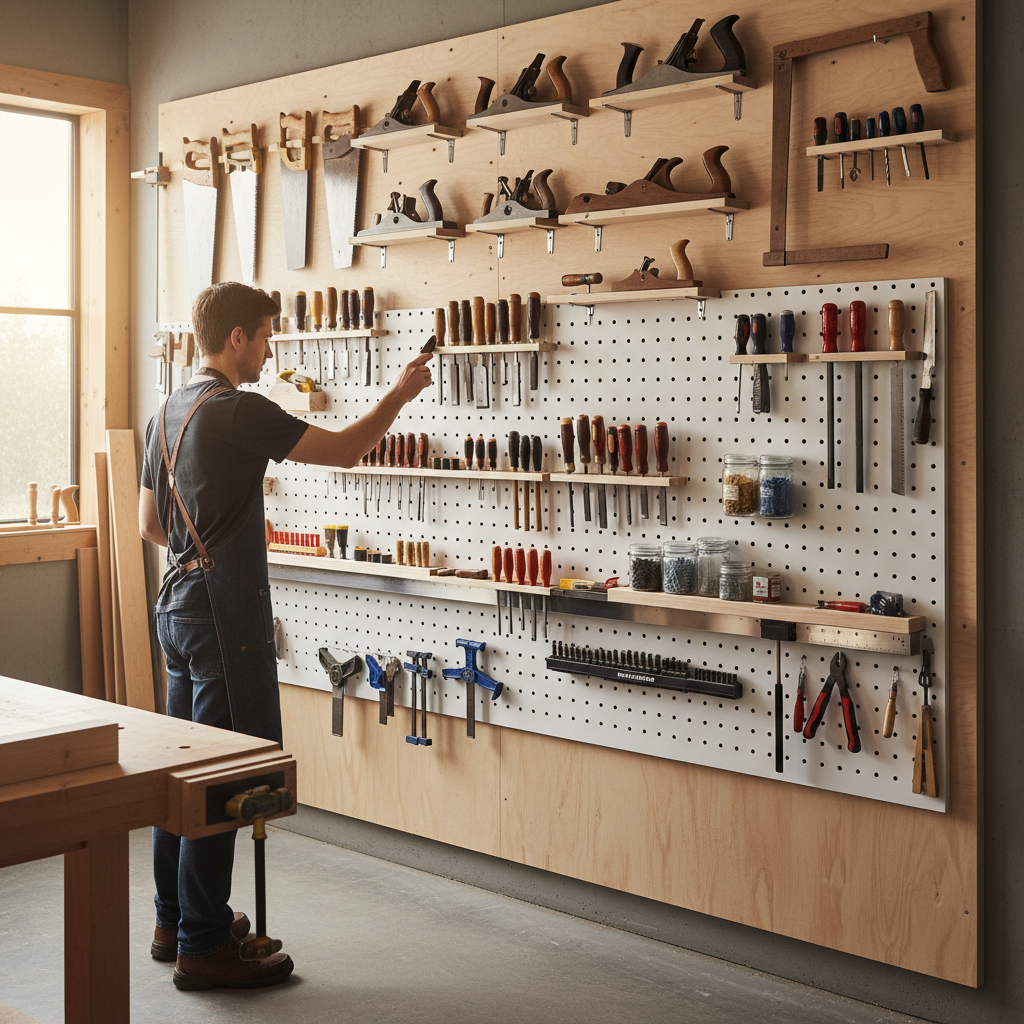Hey there, fellow woodworkers! Ever spent an hour searching for that one specific chisel, only to find it buried under a pile of sawdust and offcuts? Or perhaps you’ve felt that familiar twinge in your lower back after bending awkwardly to grab a tool from a low drawer? Yeah, I’ve been there. My workshop used to be a chaotic battleground of misplaced tools and inefficient movement. It wasn’t just slowing me down; it was genuinely causing discomfort.
That’s when I realized something crucial: my workshop needed more than just ‘organization’; it needed ergonomic organization. And for me, the game-changer was going vertical – embracing wall-mounted tool storage. If you’re tired of the clutter, the constant searching, and the aches and pains that come with a poorly laid-out shop, then you’re in the right place. Let’s dive into how wall-mounted, ergonomic storage can transform your woodworking experience.
Why Ergonomics Isn’t Just a Buzzword in Your Wood Shop
When you hear “ergonomics,” you might think of office chairs or fancy keyboards. But trust me, it’s just as vital, if not more so, in a wood shop. Here’s why:
-
Preventing Strain and Injury: Repeated bending, reaching, and twisting for tools can lead to chronic pain in your back, neck, shoulders, and wrists. Ergonomic design minimizes these awkward movements.
-
Boosting Efficiency: When every tool has its place and is easily accessible, you spend less time searching and more time making sawdust. This isn’t just about speed; it’s about maintaining your flow and focus.
-
Enhancing Safety: A cluttered workspace is a dangerous workspace. Tools left on benches can roll off, get caught in machinery, or simply be a tripping hazard. Proper storage reduces these risks significantly.
-
Improving Enjoyment: Let’s be honest, woodworking should be fun and fulfilling. When your shop is tidy, functional, and comfortable to work in, you’ll find yourself looking forward to your time there even more.
The Wall: Your Untapped Goldmine for Storage
Think about it. Most workshops, especially smaller ones, have limited floor space. Benches, machines, and lumber take up a lot. But what about your walls? They’re ofteeglected, prime real estate just waiting to be utilized. Wall-mounted storage offers incredible benefits:
-
Space Maximization: It frees up precious floor and bench space, making your shop feel larger and less cramped.
-
Instant Visibility: When tools are hung on a wall, they’re not hidden in drawers or bins. You can see what you have at a glance, making tool selection quicker and easier.
-
Better Accessibility: With the right ergonomic plaing, your most-used tools can be within arm’s reach, minimizing uecessary movement.
-
Dust Management: Tools stored on walls are less likely to accumulate dust and debris compared to those lying on benches or in open bins.
Understanding Ergonomic Principles for Your Workshop
Before you start drilling holes, let’s talk about the core ergonomic principles that guide effective wall storage. My aim here is always to reduce wasted motion and physical strain.
The “Zone” Concept
Imagine your workspace divided into zones based on how often you use tools:
-
Primary Zone (Frequent Use): These are the tools you use constantly – measuring tapes, pencils, squares, most-used chisels, screwdrivers, etc. They should be directly in front of you, between your shoulders and waist height, requiring minimal reach.
-
Secondary Zone (Moderate Use): Tools you use regularly but not every five minutes – specialty planes, marking gauges, clamps, drill bits. These can be slightly further out, requiring a short reach or a small step, typically still within comfortable standing height.
-
Tertiary Zone (Infrequent Use): Tools used occasionally, seasonal items, or less-common specialty tools. These can be stored higher up, lower down, or further away, requiring a step stool or a longer walk.
The goal is to keep your most important tools where they are easiest to grab without stretching or bending.
Logical Grouping
Group tools by function. All your measuring tools together. All your chisels together. All your screwdrivers together. This makes intuitive sense and streamlines your workflow. When you finish a task, you know exactly where to return the tool.
Popular Wall-Mounted Storage Systems – My Take
There are several fantastic wall-mounted systems out there, and I’ve tried most of them. Here’s a breakdown of what works and why:
Pegboards: The Classic Workhorse
Ah, the trusty pegboard! It’s a classic for a reason. Easy to install, relatively inexpensive, and highly versatile with a vast array of hooks, bins, and holders. I started with a pegboard, and it taught me a lot about spatial organization.
-
Pros: Affordable, easy to reconfigure, good for quick visual inventory, widely available accessories.
-
Cons: Can look messy if not carefully plaed, peg hooks can come loose easily, sometimes struggles with heavier tools without robust mounting.
-
Ergonomic Tip: Use outline guides (paint or marker) around each tool so you know exactly where it belongs. For frequently used items, ensure the hooks are sturdy and the tool is easy to lift off without snagging.
French Cleat Systems: My Personal Favorite
If you’re a woodworker, you’ve probably heard of French cleats. This system uses two interlocking 45-degree bevels (one on the wall, one on your tool holder) to create an incredibly strong and flexible mounting system. This is where I truly found my stride in ergonomic organization.
-
Pros: Incredibly strong, highly customizable (you can build specific holders for any tool), easy to rearrange tool holders with no tools required, looks professional.
-
Cons: More labor-intensive to set up initially, requires woodworking skills to build custom holders, can be bulky for very small tools.
-
Ergonomic Tip: Build custom holders that perfectly cradle each tool, making it effortless to grab and replace. Place your most-used tool holders on the cleats at chest height. Since they are easy to move, you can adapt your layout as your workflow evolves.
Custom Wall Cabinets & Shelves: Enclosed Efficiency
Sometimes, open storage isn’t ideal for every tool. Dust-sensitive items, delicate measuring instruments, or just a desire for a cleaner aesthetic might call for custom wall cabinets or enclosed shelves. I’ve built a few of these, especially for my planes and specialty hand tools.
-
Pros: Protects tools from dust and damage, can look very neat, provides secure storage, can incorporate drawers or doors.
-
Cons: Less flexible than open systems, more time-consuming to build, tools aren’t immediately visible, takes up more space depth-wise.
-
Ergonomic Tip: Use these for less frequently used or sensitive tools. Ensure the cabinet doors open easily and don’t obstruct your workspace. Interior organization (dividers, magnetic strips) is key to making tools accessible once the door is open.
Magnetic Strips & Specialty Holders: For the Finer Details
Don’t forget the smaller, often-lost items! Magnetic strips are fantastic for chisels, screwdrivers, drill bits, and small metal rules. Specialty holders can be custom-made for things like carving tools, marking gauges, or small hand planes.
-
Pros: Excellent for small metal tools, instant visual access, very space-efficient, keeps sharp edges protected.
-
Cons: Only works for magnetic tools, less suitable for heavy items, can be tricky to organize if too many tools are on one strip.
-
Ergonomic Tip: Place these near your primary workbench for quick access to frequently swapped bits or hand tools. Ensure they are mounted securely and at an easy-to-reach height.
Plaing Your Ergonomic Layout: A Step-by-Step Approach
Ready to get organized? Here’s the process I follow, which has consistently yielded great results:
-
Inventory Everything: Pull every tool out. Yes, every single one. Lay them out on your workbench or floor. This gives you a clear picture of what you actually have.
-
Categorize and Group: Start putting like with like. All your saws together, all your planes, all your measuring tools, power tool accessories, etc.
-
Assess Usage Frequency: As you categorize, mentally (or physically with sticky notes) assign each group to your primary, secondary, or tertiary ergonomic zones. Which tools do you grab multiple times an hour? Which once a week? Once a month?
-
Analyze Your Workflow: Stand in your shop and visualize your typical projects. Where do you use your bench planes? Where do you do most of your marking and measuring? Where do you switch drill bits? Your tool storage should support these natural movements.
-
Measure and Sketch: Measure your available wall space. Sketch out different layouts on paper or use masking tape on the wall to map out zones and potential storage systems. This is crucial for visualizing before you commit.
-
Start Small, Adapt, and Expand: You don’t have to overhaul everything at once. Pick one wall or one tool category to start with. Live with it for a bit. See what works and what doesn’t. My shop organization is always evolving, and yours should be too!
My Personal Journey: From Chaos to Clarity
I remember a time when my small garage workshop felt like a constant struggle. My bench was always covered, and I spent more time hunting for my tape measure than actually cutting wood. The breaking point was when I almost tripped over a clamp I’d left on the floor – a safety hazard I couldn’t ignore.
I started with a simple pegboard behind my main workbench. It was an improvement, but the pegs kept falling out, and it looked cluttered. That’s when I discovered French cleats. It took a weekend to install the cleat strips across one entire wall, but it was worth every minute. I then spent several evenings building custom holders for my hand planes, chisels, saws, and measuring tools. Each holder was designed to perfectly fit its tool, making it easy to grab and even easier to return.
The transformation was incredible. Not only did my shop look infinitely cleaner and more professional, but my workflow became smoother, faster, and more enjoyable. My back pain, which I’d just accepted as part of woodworking, noticeably reduced. I wasn’t bending, twisting, or reaching awkwardly anymore. Every tool was where I needed it, when I needed it.
Maintenance & Evolution: Keeping Your System Agile
Here’s a little secret: organizing your shop isn’t a one-time event. As your tools collection grows, as your projects change, or as your body ages, your ergonomic needs might shift. My system evolves every few months.
-
Regular Review: Every few months, take a critical look at your setup. Are there tools you’re always reaching for that aren’t in the primary zone? Are some tools rarely used but taking up prime real estate?
-
Don’t Be Afraid to Adjust: The beauty of systems like French cleats or even well-plaed pegboards is their flexibility. Move things around. Experiment. Find what truly works best for *you*.
-
The “One In, One Out” Rule: For new tools, try to find a dedicated spot before you even bring it into the shop. If space is tight, consider if a new tool means an old, unused one can be donated or sold.
Conclusion: Invest in Your Comfort and Efficiency
Adopting ergonomic wall-mounted tool storage isn’t just about tidying up your shop; it’s an investment in your physical well-being, your efficiency, and ultimately, your enjoyment of woodworking. You’ll spend less time searching, less time in discomfort, and more time doing what you love – creating beautiful things from wood.
So, take that first step. Look at your walls with new eyes. Imagine a workshop where every tool has a home, where you move with ease, and where your back thanks you at the end of a long day. It’s absolutely achievable, and it’s one of the best decisions I ever made for my woodworking journey. Happy organizing, and even happier woodworking!



